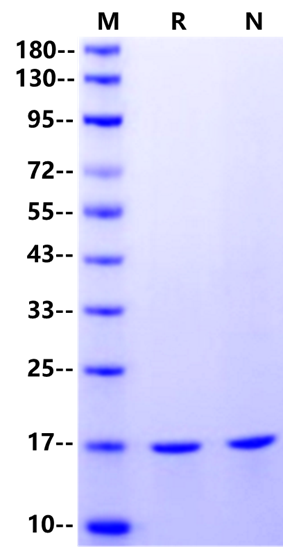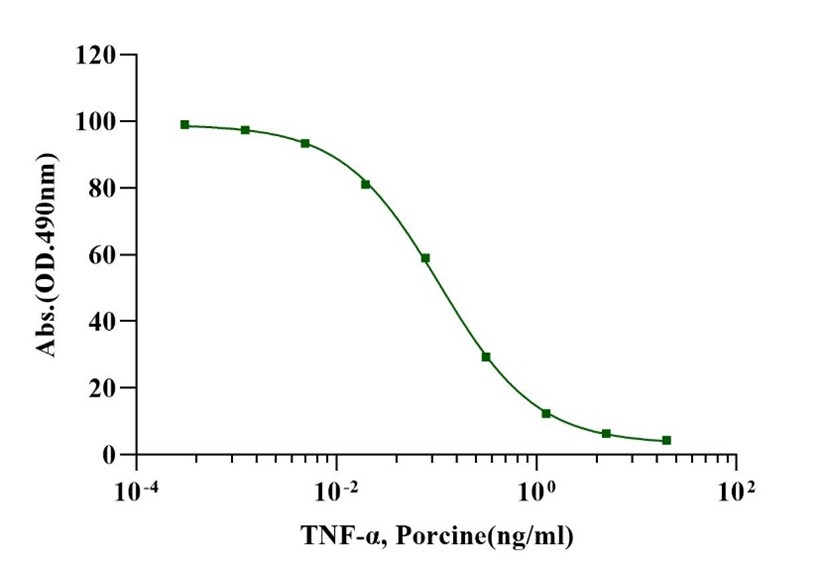



 下载产品说明书
下载产品说明书 用小程序,查商品更便捷
用小程序,查商品更便捷



 收藏
收藏
 对比
对比 咨询
咨询









1μg (R: reducing condition, N: non-reducing condition).
"}]

Tumor necrosis factor alpha (TNF-alpha), also known as cachectin and TNFSF2, is the prototypic ligand of the TNF superfamily. It is a pleiotropic molecule that plays a central role in inflammation, immune system development, apoptosis, and lipid metabolism. Porcine TNF-alpha consisits of a 35 amino acid (aa) cytoplasmic domain, a 21 aa transmembrane segment, and a 176 aa extracellular domain (ECD). Within the ECD, porcine TNF-alpha shares 69%-86% aa sequence identity with bovine, canine, cotton rat, equine, feline, human, mouse, rat, and rhesus TNF-alpha . TNF-alpha is produced by a wide variety of immune, epithelial, endothelial, and tumor cells. TNF-alpha is assembled intracellularly to form a noncovalently linked homotrimer which is expressed on the cell surface. Cell surface TNF-alpha can induce the lysis of neighboring tumor cells and virus infected cells, and it can generate its own downstream cell signaling following ligation by soluble TNFR I. Shedding of membrane bound TNF-alpha by TACE/ADAM17 releases the bioactive cytokine, a 55 kDa soluble trimer of the TNF-alpha extracellular domain. TNF-alpha binds the ubiquitous 55-60 kDa TNF RI and the hematopoietic cell-restricted 80 kDa TNF RII, both of which are also expressed as homotrimers. Both type I and type II receptors bind TNF-alpha with comparable affinity, although only TNF RI contains a cytoplasmic death domain which triggers the activation of apoptosis. Soluble forms of both types of receptors are released and can neutralize the biological activity of TNF-alpha.


· 3 months, -20 to -80℃ under sterile conditions after reconstitution.
· 1 week, 2 to 8℃ under sterile conditions after reconstitution.
· Please avoid repeated freeze-thaw cycles.
1. Zelova, H. and J. Hosek (2013) Inflamm. Res. 62:641.
2. Juhasz, K. et al. (2013) Expert Rev. Clin. Immunol. 9:335.
3. Pauli, U. et al. (1989) Gene 81:185.
4. Tang, P. et al. (1996) Biochemistry 35:8216.
5. Perez, C. et al. (1990) Cell 63:251.
6. Black, R.A. et al. (1997) Nature 385:729.
7. Moss, M.L. et al. (1997) Nature 385:733.
8. Gearing, A.J.H. et al. (1994) Nature 370:555.
9. Schall, T.J. et al. (1990) Cell 61:361.
10. Loetscher, H. et al. (1990) Cell 61:351.
11. Dembic, Z. et al. (1990) Cytokine 2:231.
12. Smith, C.A. et al. (1990) Science 248:1019.
13. Loetscher, H. et al. (1991) J. Biol. Chem. 266:18324.
14. Pinckard, J.K. et al. (1997) J. Biol. Chem. 272:10784.
15. Engelmann, H. et al. (1990) J. Biol. Chem. 265:1531.

参考图片
1μg (R: reducing condition, N: non-reducing condition).
Measured in a cell proliferation assay using L-929 mouse fibrosarcoma cells, the EC50 for this effect is less than 0.1ng/ml.






 危险品化学品经营许可证(不带存储) 许可证编号:沪(杨)应急管危经许[2022]202944(QY)
危险品化学品经营许可证(不带存储) 许可证编号:沪(杨)应急管危经许[2022]202944(QY)  营业执照(三证合一)
营业执照(三证合一)